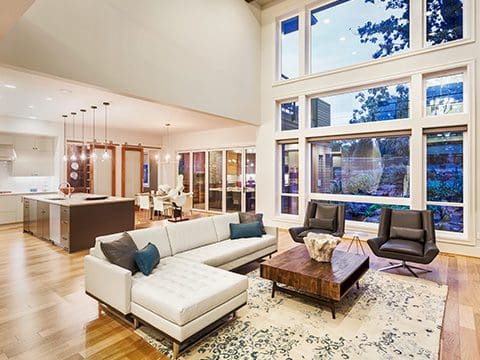Engineered Hardwood Flooring
Have you ever heard of engineered hardwood flooring? You’ve probably walked on it at some point, but you probably thought it was real hardwood! While engineered hardwood shares many similarities with real wood, there are some main differences worthy of taking note of:
Layered composition
Engineered hardwood is a combination of laminate and real hardwood. It has a layered composition like laminate flooring. It also looks just like real hardwood. Consider it to be a hybrid of the best qualities of both laminate and hardwood.
The bottom layer of engineered hardwood flooring is a moisture-resistant core, the top layer is your choice of hardwood, and the middle layers are plywood. The top layer is normally coated with at least five polyurethane-based layersto best protect it from wearing down.
The moisture-resistant bottom layer allows engineered hardwood to be installed in areas where real hardwood can’t, like kitchens!
Durability
Engineered hardwood flooring can last for quite a while and typically comes with a 30-year warranty. Its hardness is comparable to real hardwood, and its moisture resistance makes it even more long-lasting.
As we mentioned earlier, engineered hardwood flooring offers more flexibility than real wood in terms of where it can be installed. Hardwood flooring can be installed in kitchens and bathrooms, but it’s considered quite a risky move for a homeowner. Generally speaking, engineered hardwood flooring eliminates such risks for areas like kitchens and bathrooms.
Maintenance
All you’ll need to maintain engineered hardwood flooring is a damp mop and a vacuum. Since engineered hardwood flooring is quite resistant to moisture, you won’t have to worry about waiting for your floors to dry when mopping. Mopping once or twice a week will be enough to help keep your flooring in perfect condition. Vacuuming is fine as well, but can cause scratching if not on the proper setting. While engineered hardwood flooring can handle moisture well, you should still wipe up spills immediately to eliminate any possibility of the floors being damaged.
Price
Engineered hardwood flooring typically ranges from $4-$15 per square foot. While it’s not extremely cheap, it’s still less expensive than real wood. Additionally, the cost of installation for engineered hardwood flooring is lower, and it does not require staining like real hardwood does.
One disadvantage of engineered hardwood, though, is that it can only be sanded and refinished once or twice. The reason for this is that the top layer is thin and can only be sanded once or twice. In order to make the most of your engineered hardwood flooring, make sure to consult a flooring expert before having them refinished.
Versatility
Enginnered hardwood flooring has the exact same visual appeal as real hardwood. As we mentioned earlier, it is because engineered wood is topped with real hardwood.
The versatility of engineered hardwood flooring isn’t at all limited. Essentially, any type of hardwood can be turned into engineered hardwood flooring. This includes everything from bamboo to cherry wood. The wood of your choice will serve as the top layer of the engineered planks.
If you’re interested in engineered hardwood flooring, contact Floors Touch! Our experts will provide you with an estimate and even install your flooring. If you’re not quite sold just yet, we’ll be more than happy to answer any questions you might have. Call Floors Touch today at (214) 326-0100! Also, check out our blog for more helpful flooring and home remodeling information. You can also visit our social media for more details.
Do you want to know more about our home flooring solutions? Call Floors Touch of McKinney at (214) 326-0100 for more information.
